Burst Into Spring with Eastern Redbud
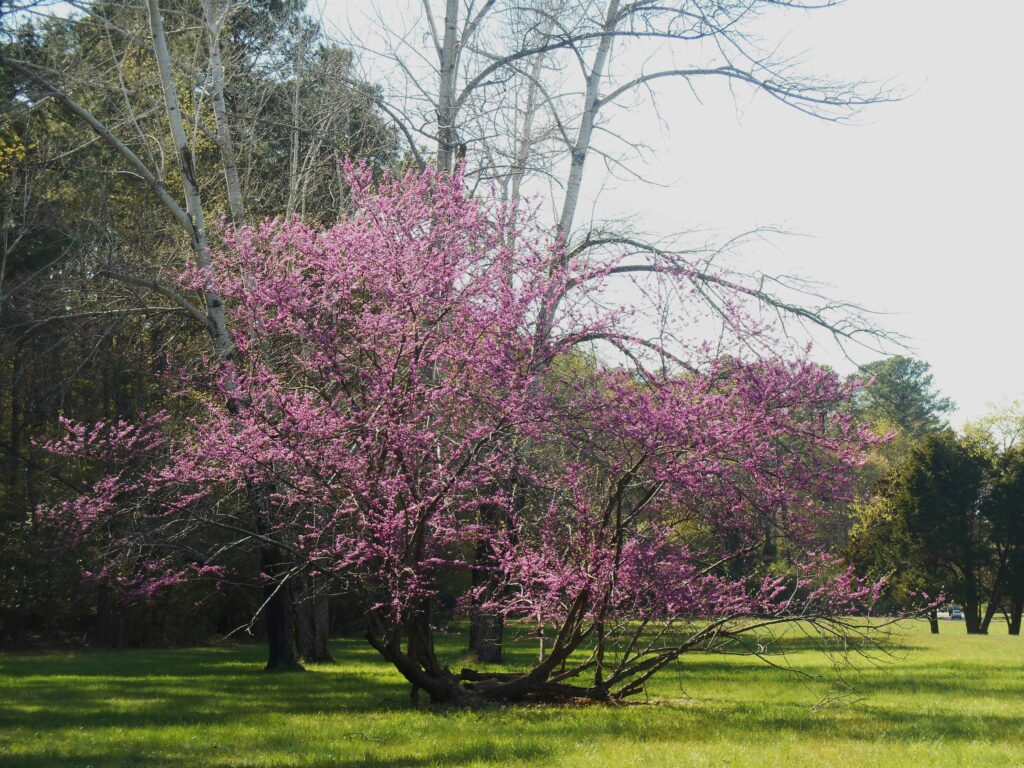
An ancient Eastern redbud blooms in mid-April, 2015, along the Colonial Parkway near Jamestown Island.
A Beacon of Spring
A blooming redbud tree grabs my attention like no other spring flowering tree. It just suddenly lights up like a neon beacon glowing brightly in the edge of the wintery forest; transforming from non-descript to gorgeous in the space of a day.
Unlike other spring blooming trees which show visibly swelling buds for weeks, while they wait for winter’s cold to pass; clusters of redbud blossoms simply break directly out of its bark, anywhere and everywhere along its trunks and branches. It feels almost miraculous to watch delicate flowers emerge from grey bark in earliest spring, while other deciduous trees in the forest remain dormant. Eastern redbuds bloom soon after the yellow Forsythia shrubs bloom each year, but a week or more before the dogwood’s buds break open.

The buds of Eastern redbud flowers emerge from the bark along the trees branches. Unopened buds like these may be picked and pickled for use much like capers.
The redbud’s flowers emerge days before its leaves unfold. They bloom while the surrounding forest remains wintery, with just a hint of maple’s scarlet buds and a soft green haze heralding bud break of other deciduous trees. Redbud’s flowers remain in bloom for several weeks, feeding bees and other nectar-loving insects in very early spring when there are few other flowers in bloom.
An Iconic American Tree
Our native Eastern redbud, Cercis canadensis, remains a quintessentially American tree. Hardy in Zones 4-9, they grow as far west as New Mexico, and from the Hudson Bay south to the Gulf coast in Eastern North America. They are indigenous in all regions of Virginia. Never growing particularly tall, only to 20’-30’, redbuds survive to an advanced age. And as they age, they keep growing horizontally, often expanding into a clump wider than the tree is tall, and blooming year after year despite all manner of scars, injuries, and chaotic growth. They have that courageous spirit of perseverance which expresses the heart and spirit of springtime’s beauty.
Eastern redbuds may be used in landscapes as small trees or as large shrubs. They are much safer trees to grow near homes than larger trees like pine, oak, and beech because of their smaller size. There is no worry about them falling on a house or garage during a storm. Redbuds may be planted as focal points in the landscape, used in mixed borders, incorporated into hedgerows, and used along the edge of wooded areas.
Redbud remains an understory tree in the wild, often growing in the partial shade of the forest’s edge and under larger shade trees in neighborhoods. Redbud trees will grow in full sun or partial shade, on most soil types, and are drought tolerant once they are established because they develop a deep taproot. Redbuds tolerate summer heat and humidity so long as the soil has moisture, and they are rarely bothered by deer or rabbits. Provide some irrigation during summer drought if the tree is growing in full sun. They grow best in acidic to neutral soil and appreciate organic mulch like leaf litter or wood chips.
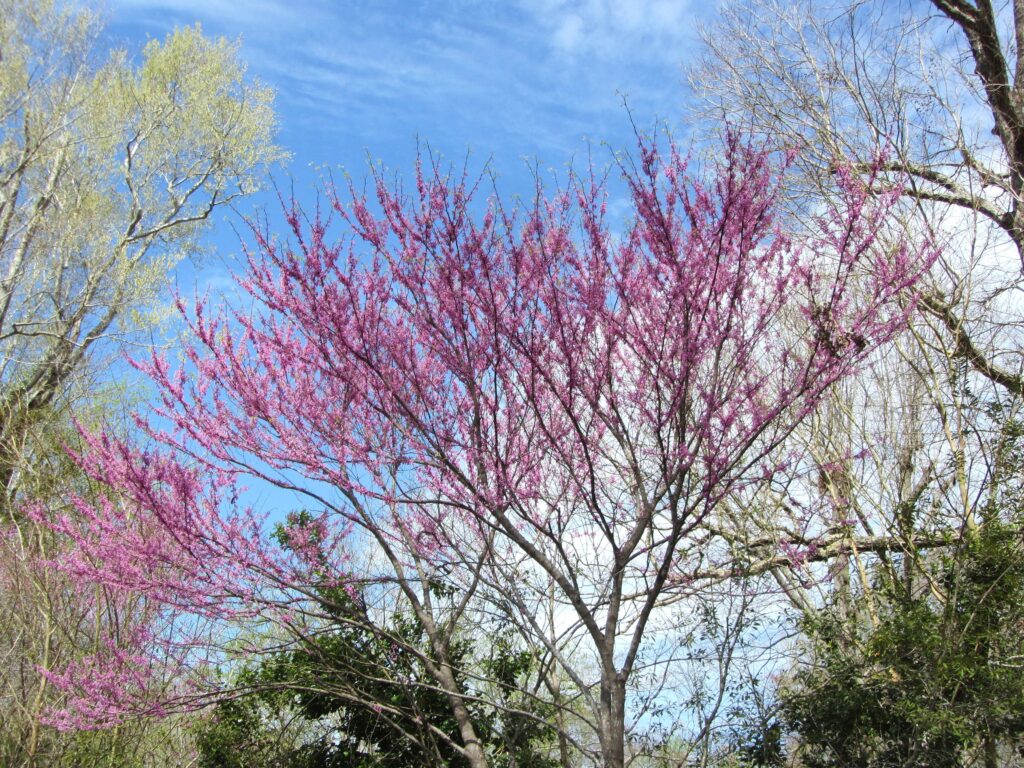
An Eastern redbud tree blooms in James City County in late March 2023. This is a wild-form volunteer of the species, indigenous to our community.
The redbud is a member of the pea, or Fabaceae family. Every flower, once pollinated, forms a seed pod which look like an edible Asian snow pea pod. You can imagine that in a few months’ time the pods hang thickly from the branches. The flowers, flower buds, and seedpods are all edible and were used by Native Americans for food. The flowers are generally eaten fresh, as garnishes and in salads. Flower buds may be pickled and used like capers. The new, green seedpods resemble snow peas and are used the same way, either raw, steamed, or lightly stir fried. Native Americans made medicinal tea from the tree’s bark, which they used to treat a variety of health concerns.
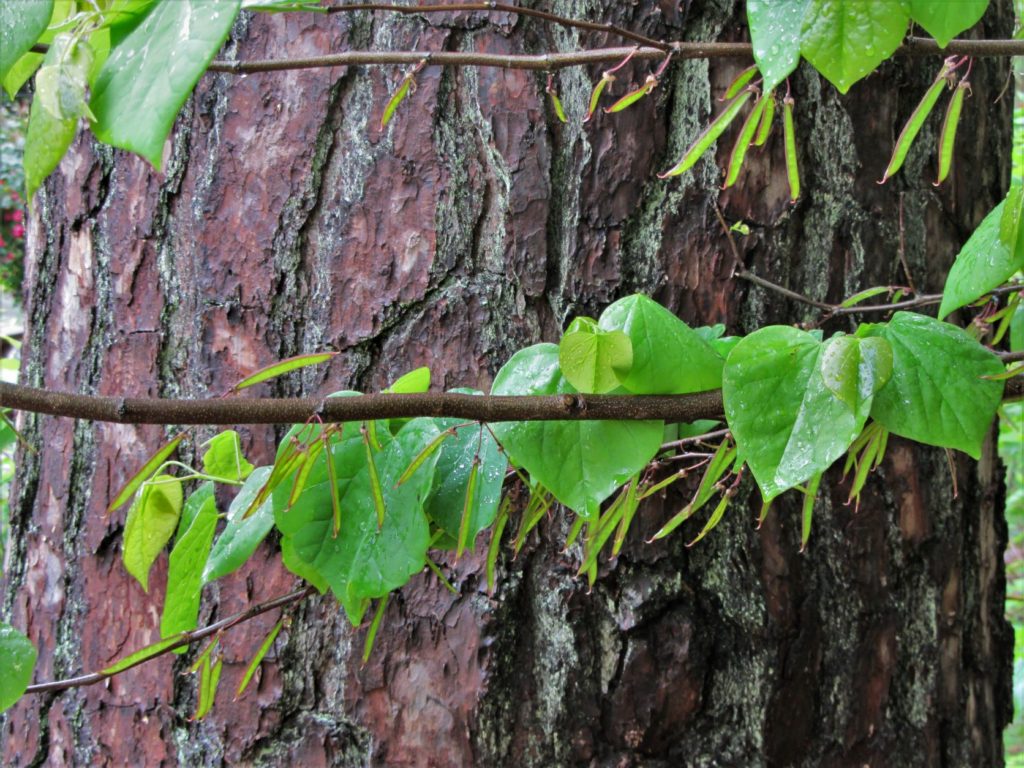
Seedpods on C. canadensis may be picked and eaten like pea pods. Cercis is a member of the pea family and is both edible and medicinal. This tree grows at Williamsburg Botanical Garden and Freedom Park Arboretum.
Twelve species of lepidoptera use redbud leaves as their host. Redbud flowers attract a wide range of pollinators, including native bees. Birds and other small animals will sometimes eat the seedpods, and later the dried seeds. Each pod contains about 4 to 9 seeds, which are both tasty to wildlife and easy to germinate.
Propagate Eastern Redbud From Seeds
Collect seeds from a healthy tree in late summer or early autumn. Remove the seeds from their pods and then select the largest, plumpest of the seeds to soak in hot water for six hours or overnight. Sow the seeds into compost or good potting soil in a shallow seed flat. After watering in the seeds, seal the flat into a plastic food storage bag and store the bag in the refrigerator for 60 to 90 days so the seeds can stratify. Note the date you sowed the seeds, and the date to remove them from cold storage on the bag. Alternatively, place the seed flats in their bag outside in a sheltered area where they will be exposed to winter temperatures. Seedlings should emerge in the spring, and the flat can be removed from its bag once seedlings are visible.
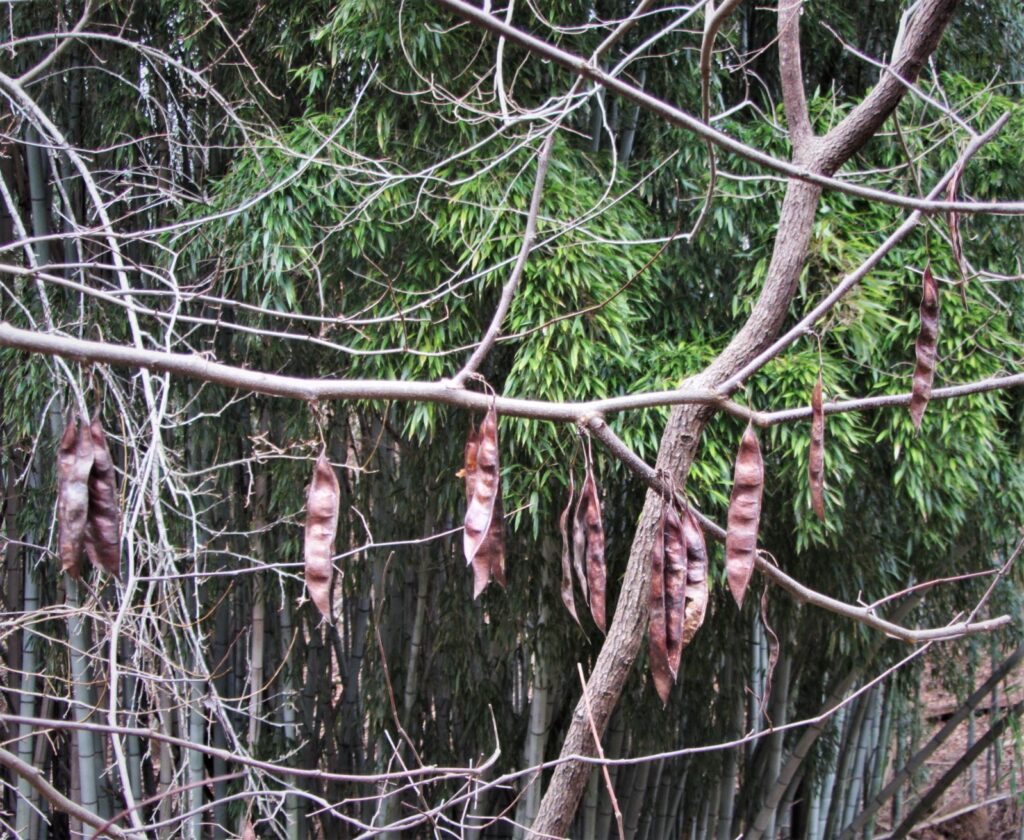
Seed pods linger on Eastern redbud through the winter. Birds and other small animals may use these seed pods as winter food. Seed pods that fall to the ground, where the seeds can absorb water from the soil and begin to germinate, should show new growth the following spring.
So many seeds form each summer that many survive to germinate in the wild from fallen seed pods. The trees grow very quickly. They shoot up in just a few years to get their branches high enough to catch the sunlight through the surrounding growth. Redbuds begin to bloom when they are between 3 and 5 years old. Rather skinny at first, they slowly begin to fill out their rounded, somewhat flat topped canopies as the years go by.
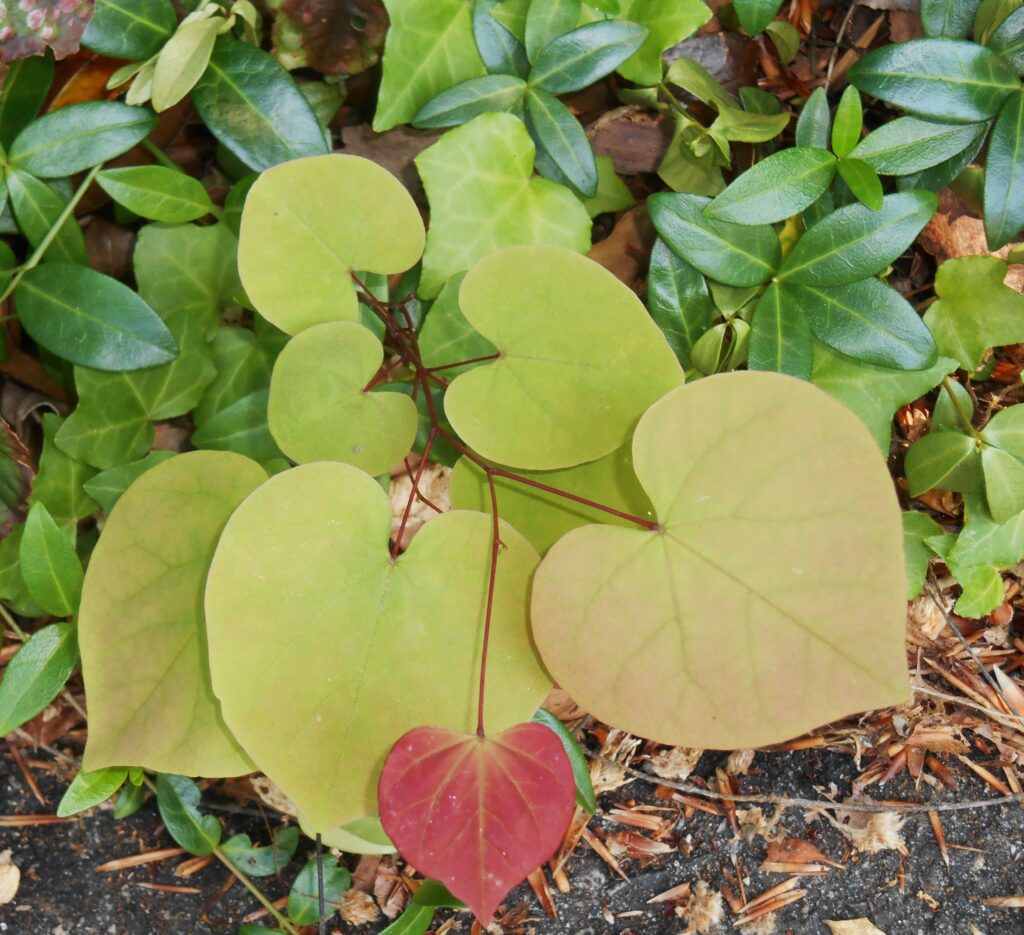
Newly emerging leaves on a redbud tree may be red or pink. Seedlings have been selected for leaf color and patterns and then propagated and sold as cultivars of this native species. This is a volunteer seedling that emerged in our yard. The photo was taken in May of 2018.
Redbuds have beautiful, broad, heart shaped leaves. The wild species has medium green leaves that turn gold in autumn before they fall. Modern cultivars offer purple, gold, and variegated white and green leaves. Foliage remains healthy and attractive until it turns yellow in early autumn.
Redbud Trees Improve the Soil for Other Plants
Redbud trees, like other members of the pea family, help improve the soil and nourish other plants. All legumes fix nitrogen, absorbed from the air, into the nodules on their roots in cooperation with specific bacteria in the soil. These nodules fertilize the soil. Mycorrhizae living in the soil can also move this nitrogen from the redbud’s roots to nourish other plants. The tree’s fallen leaves and seed pods also protect and feed the soil as they decompose each winter.
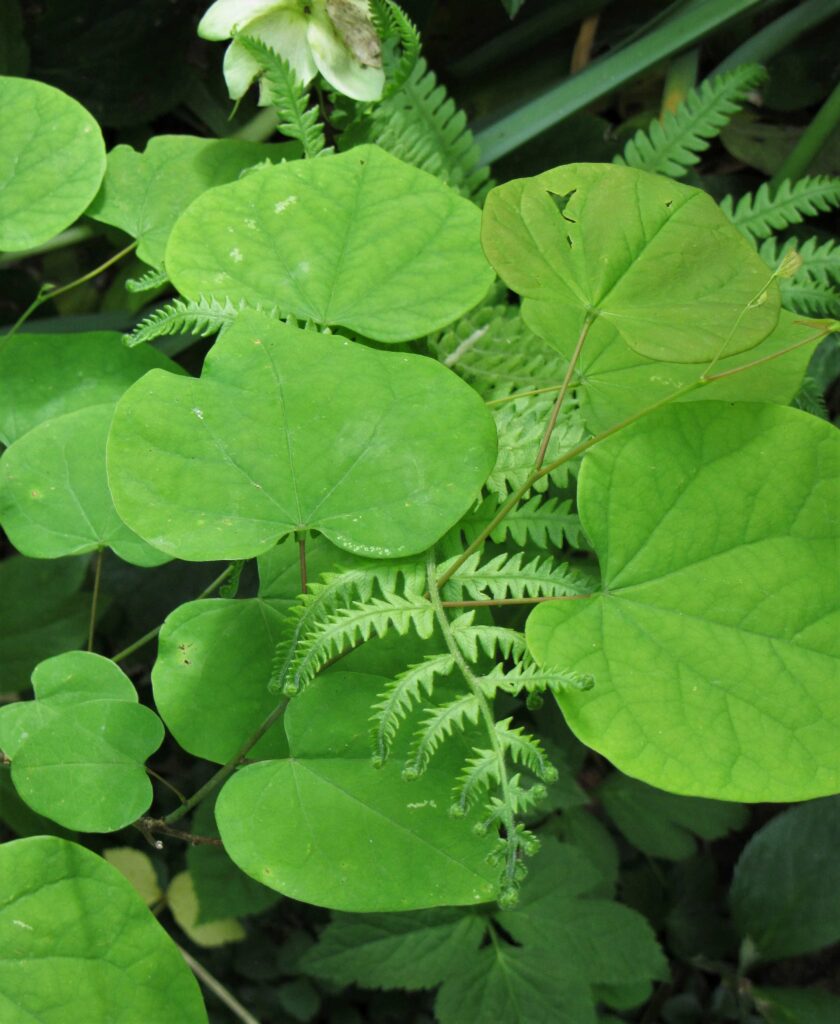
Redbud trees are good companion plants in mixed plantings because they fix nitrogen in the soil, thus taking nitrogen from the air and transforming it into a form usable by nearby plants. Use redbuds to anchor planting beds for shade loving perennials. Thelypteris palustris ferns grow under a young volunteer C. canadensis in late spring.
The native Eastern redbud grows wild in our woods and in some neighborhoods, where the developers protected native trees during construction. Although there are many beautiful cultivars available now, including a white flowering variety, the wild species form is still the most common. Landscape professionals will probably recommend specific cultivars since they are produced commercially and so more easily obtained from nurseries. While wild form trees generally grow on their own roots, most of the cultivars are grafted onto other rootstock. Propagate your own redbud saplings from collected seeds or from rooted cuttings.
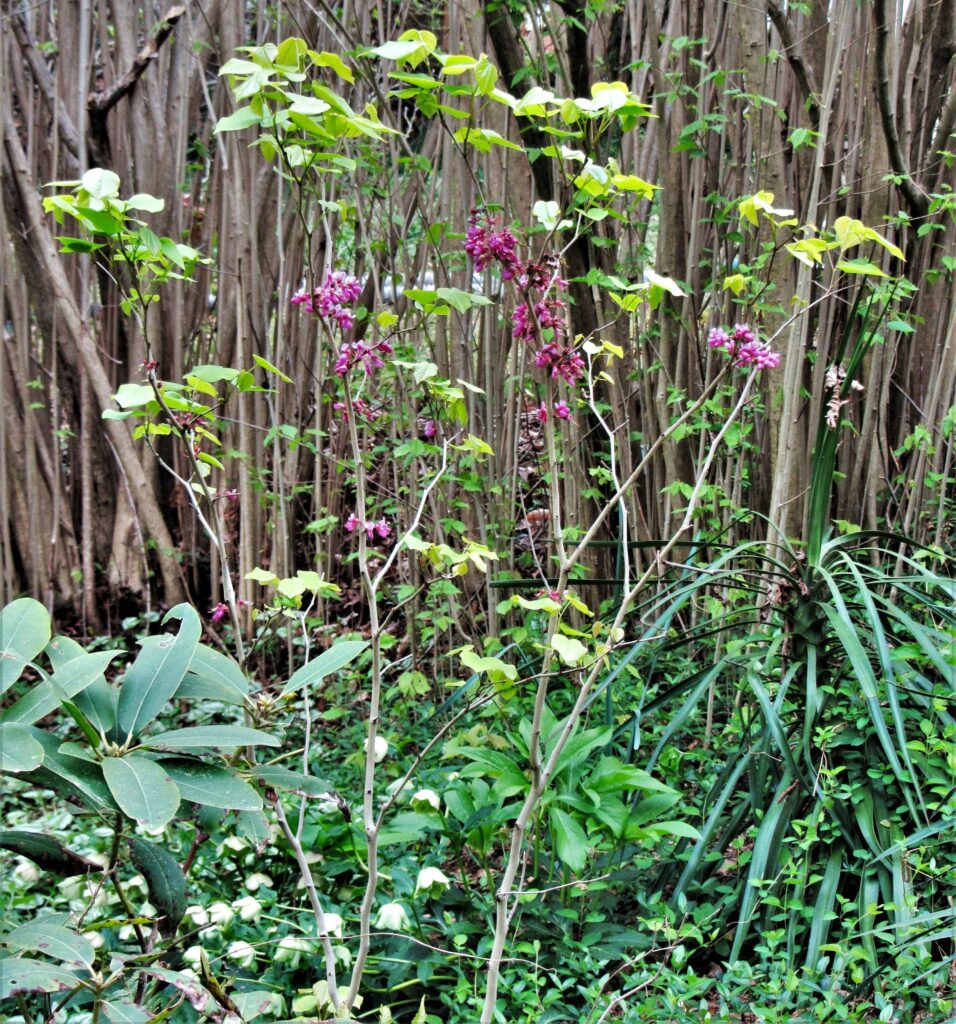
This unnamed redbud cultivar came as a gift from friends. I grew it in a container with bulbs, ferns, and perennials for a few years before transplanting the entire clump to this shady areas of the yard. It is underplanted with hellebores and Vinca, and grows between a Rhododendron and native American hazelnut. This photo was taken in its second spring to bloom after transplanting.
Other Redbud Species for Our Area
In addition to our East Coast native C. canadensis, several other beautiful Cercis species are available to landscapers. Chinese C. chinensis, native to central China, grows to around 15’, a shorter height in North America than it does in its Asian home. It normally remains smaller than C. canadensis and assumes a more shrub-like form. Its flowers are a bit larger than our native redbud and while it attracts pollinators, it is not a host plant for butterflies and moths. It is hardy in Zones 6-9 and its culture is the same as for our native species. Chinese redbud, C. chingii, is another popular Chinese species from Southern China that is hardy in Zones 7-8, and has larger flowers and glossy, leathery foliage.
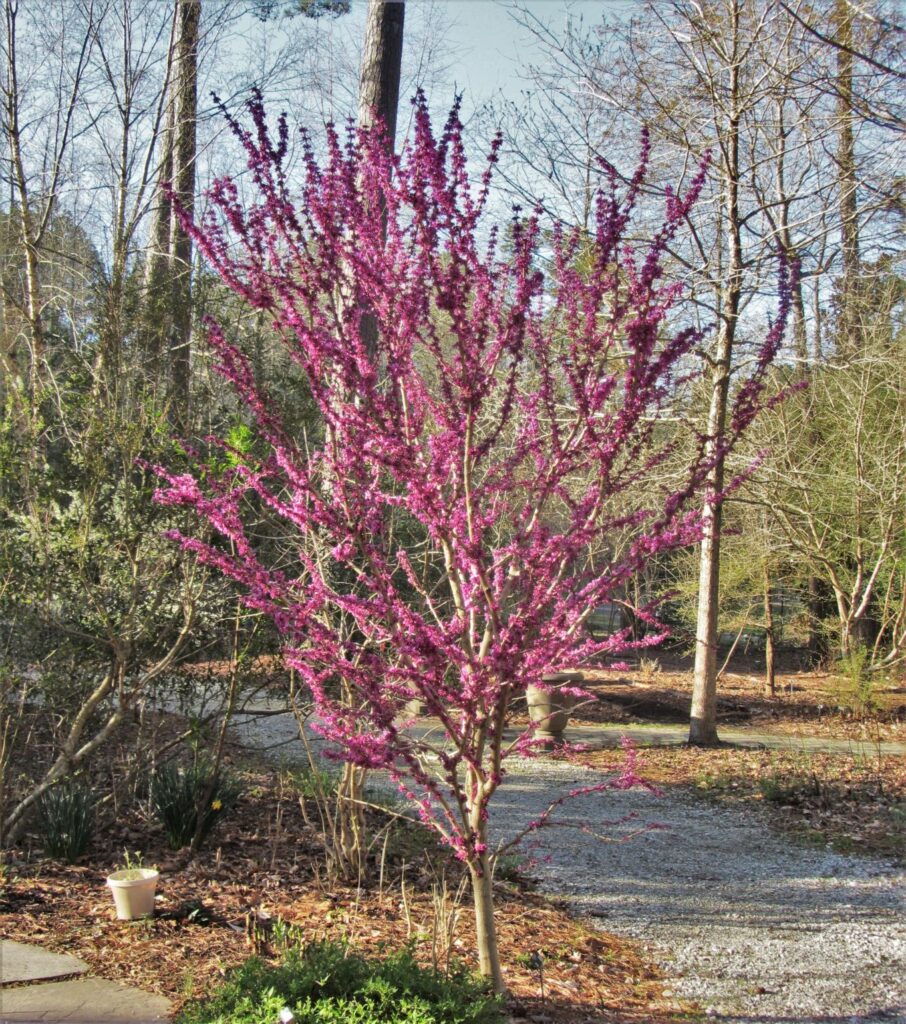
Chinese C. chinensis blooms at the Williamsburg Botanical Garden and Freedom Park Arboretum in March 2021. The tree was donated by a garden steward in memory of his late wife.
Western redbud, C. orbiculate, is adapted to the drier, sometimes more alkaline soils of the Southwest and is hardy in Zones 6-9. It can be seen growing in the wild in the Grand Canyon. It grows 15’-25’ high and wide in full or partial sun. Native Americans used its wood for making bows and its bark and young shoots for making baskets.
The Judas tree, C. siliquastrum, is a European Cercis which grows from France to the Eastern Mediterranean region of the Middle East. It grows to 25’ in Zones 6-9, and its flowers are slightly larger than our native. It prefers neutral soil and grows in full to part sun, producing somewhat larger flowers than our Eastern redbud.
Flowers on all of these species are less than an inch in length, pea shaped with 4 to 5 petals, and generally bloom in shades of pink. Some are more magenta or a purplish pink, others more reddish, and some cultivars of our Eastern redbud even have white flowers.
Redbud Trees in the Garden
We were happy to find several redbud trees blooming in our garden during our first spring on this property. There is one very large old one in the back near the ravine which blew over in a storm several years ago and now touches the ground on a slope, but it continues to grow its canopy vertically and still blooms each spring. There are also several much younger redbuds along the street where we spot a new one in bloom every year or so. New seedlings appear most summers, and I’ve planted a few seedling trees from the Arbor Day Foundation. We were given a cultivar as a gift some years ago, too, and it is quite pretty when it blooms.

This redbud tree blew over in a storm, coming to rest against the slope of our ravine. It has continued to grow its canopy vertically and blooms each spring. Mid-March 2024.
Redbud Tree ‘Insurance’
Although mature redbud trees aren’t popular with deer, the seedlings may be too tempting to ignore. If you are planting young redbud trees you are wise to protect them with commercial tree guards or chicken wire cages for their first few years. If you don’t enclose them in some way, and you have deer traffic in your yard, then consider using deer repellents around the new trees for at least a year. Nursery grown trees will be high in nitrogen when you receive them and deer love to snack on nitrogen rich, heavily fertilized leaves and twigs.
When a volunteer seedling sprouts in the ‘wrong’ place, it can be dug and moved while young. Dig more deeply than you expect to need to dig based on the size of your seedling, keeping in mind that its root system will develop more rapidly than its stems. Plant or move redbud trees while they are young because this tree develops a long tap root and doesn’t respond well to moving if the taproot is damaged.
Redbud trees can be grown in large containers for a few years to anchor a planting with perennials, ferns, bulbs, and vines. I used my gifted redbud this way on a patio for a few years. When the tree grew too large to keep in its container, I excavated a hole in the garden and put the entire contents of the container into the hole together for a bit of ‘instant’ landscaping in that spot.
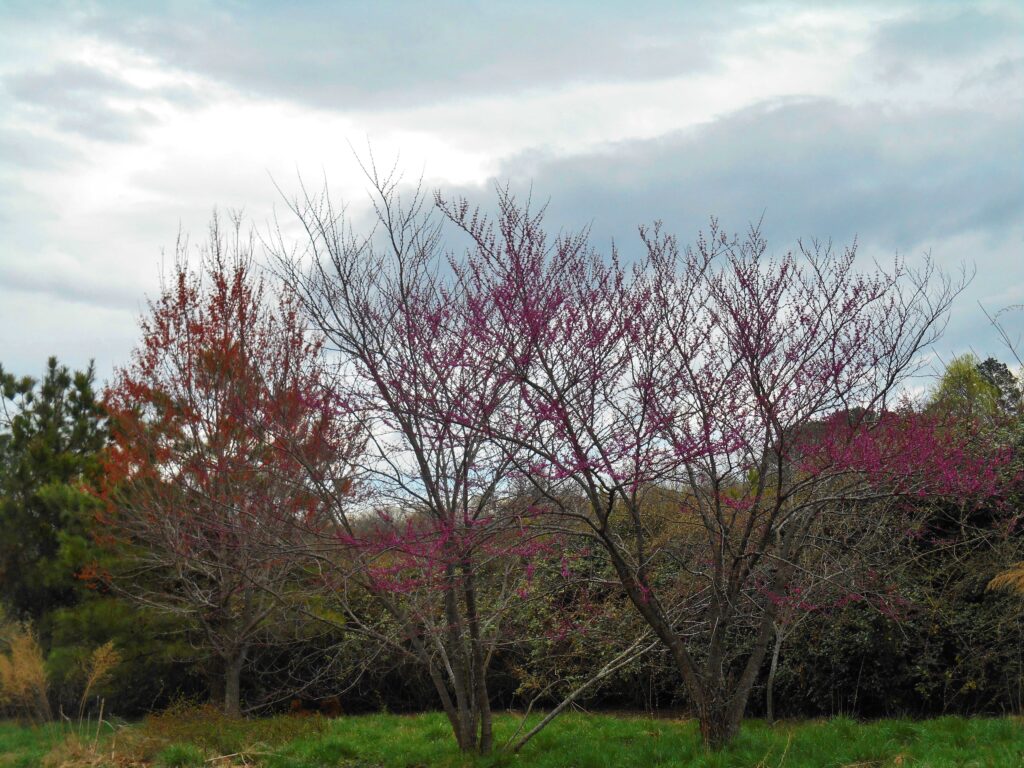
Redbuds grow along a roadside in James City Count, Virginia. A maple tree is in bud to their left. Notice that redbud flowers are more purplish pink while budding maple leaves are more red. These two trees may be confused in early spring.
Caring for Redbud Trees
Redbud trees respond well to pruning and should be checked each winter for any dead or damaged wood. It also helps to prune any healthy branches that are rubbing against one another, or are growing back into the mass of the tree, to open up the canopy a bit. This improves the appearance and health of the tree. Remove living wood with clean, sharp secateurs or a pruning saw.
I needed to remove a healthy branch that had grown into a path this winter. So, I trimmed it further into shorter lengths to try using its youngest wood as hardwood cuttings. Each cutting, mostly the young side branches and the tip of the branch, was between 6” and 10” long and I simply stuck them 2/3 of their length deep into the moist soil of a bank where I would like to have a cluster of redbud trees. I expect these hardwood cuttings will root without the benefit of the bottom heat and controlled environment most horticulturalists recommend for softwood or semi-ripe cuttings taken in summer. The specialized cells located at the base of each young side branch will encourage rooting. The cuttings that successfully root this spring will simply grow on where they are planted.
From late March through mid-April, when the redbuds are in full bloom, the dogwoods are opening, and the Azalea buds have begun to swell, is one of my favorite times of the year. The bare woody bones of winter burst into vivid flowers and cover themselves with tender green leaves. What astounding beauty manifests all around us each spring.
These are a Selection of Native Redbud Cultivars Recommended for Our Area:
White Flowering: ‘Alba,’ ‘White Pom Poms,’ ‘Royal White’
Burgundy to Purple Leaves: ‘Merlot,’ ‘Forest Pansy,’ ‘Carolina Sweetheart,’ ‘Ruby Falls’
Variegated Foliage: ‘Whitewater,’ ‘The Rising Sun,’ ‘Silver Cloud,’ ‘Floating Clouds’
Weeping Form: ‘Carolina Sweetheart,’ ‘Whitewater,’ Ruby Falls,’ ‘Vanilla Twist’
All Photos by E. L. McCoy
Related Posts on This Website:
Natural Plant Fertilizers for Your Garden
Cultivating a Tiny Forest Part 1, Part 2
Sustainable Gardening in the Shade
Growing Indigenous Trees from Seeds








